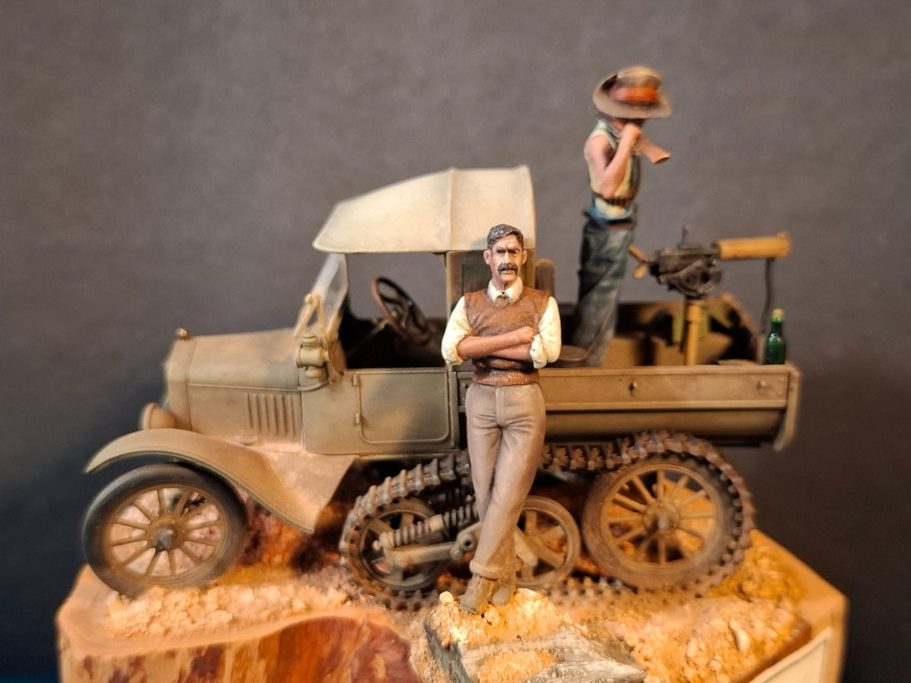
Model T Halftrack
1/35th scale plastic kit conversion from ICM
Model accembled and painted in 2024

I’m on a Whatsapp with a few friends, one of whom seems to find some very strange looking vehicles now and then – the WWI armoured motorbike that was a Photoshop hoax, the JagdAbrams, another one done with photo manipulation, and then a couple of genuine ones, including, as it turned out, several Model T Ford cars that were converted into half tracks.
Photos #1 and #2 show one such that is a museum exhibit, and there are several other versions pictured online, from being used in postal service in the US during heavy snowstorms, to ones simply made for rougher terrain.
Whilst the one pictured does seem to be for travelling in snowy or icy conditions, I thought that maybe using one in a military setting, with the likelihood of very rough ground might have been possible. Let’s say in a country that wasn’t perhaps as technologically advanced in it’s inland country regions, but where local ingenuity was just as clever and adaptable as anywhere else in the world.
So my mind turned to conflicts that were pre-WWII and came up with a Spanish Civil War setting.
!936 to 1939 were great turmoil for Spain, with a failed coup in July of 1936 against the Republican government by a group of generals in the Spanish Republican Army.
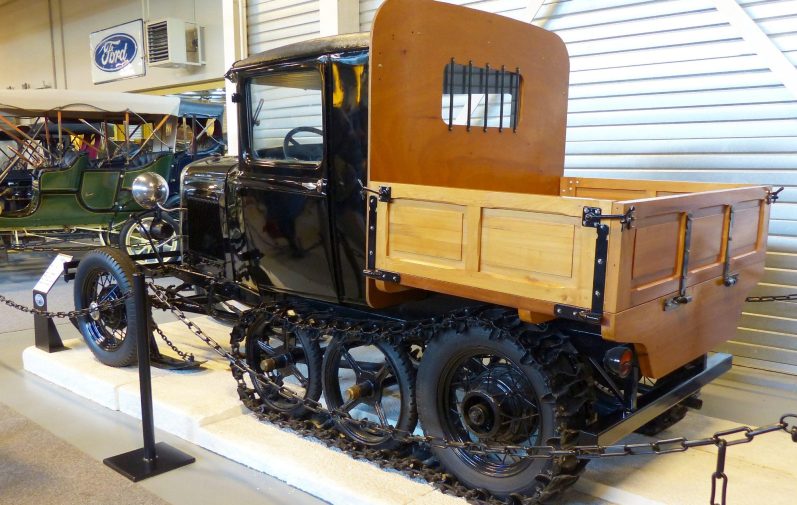
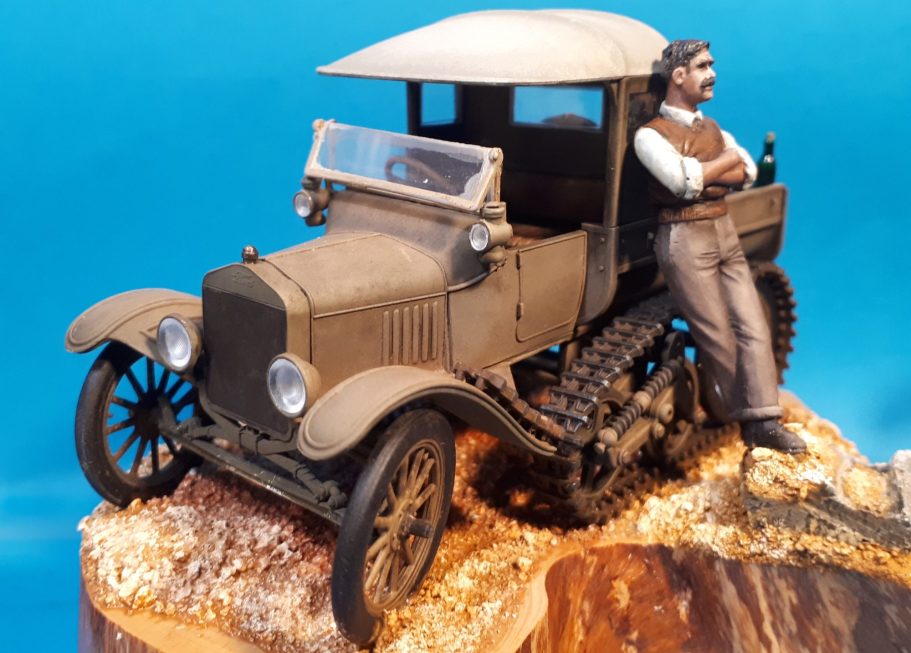
General Emilio Mola was the man with the plan although General Jose Sanjurjo was the figurehead behind whom the forces were rallied.
The government meanwhile were a coalition of Republicans supported by Communist and Socialist parties lead by Manuel Azana.
Whilst the coup failed, the Nationalist party- with several conservative groups along with monarchists and religious conservatives stepped in to support the overthrow of the Republicans.
Whilst the military seems to have been split in it’s support for either side, with Morocco, Pamplona, Burgos, Zaragoza, Cadiz, Malaga and Seville came out to support the coup, other cities – Madrid, Barcelona, Valencia, Bilbao, Murcia and Almeria remained in the hands of Government ( Republicans )

Although the Spanish Civil War has been reffered to as the rehearsal for WWII, it isn’t completely true. The country was divided politically and militarily, and each side received help from outside in the form of materiel and soldiers.
In the case of the Nationalists, they were supported by Fascist Italy, Nazi Germany and Portugal, whilst the Republicans were given aid from the Soviet Union, Mexico.
Other countries such as the UK, France and the USA continued to recognise the Republican government, but followed the official non-intervention policy.
However, it didn’t stop tens of thousands of citizens from these countries participating in the war.
The Nationalists attacked from their strongholds in the south and west of Spain, neutralising and holding the northern coastline in 1937.
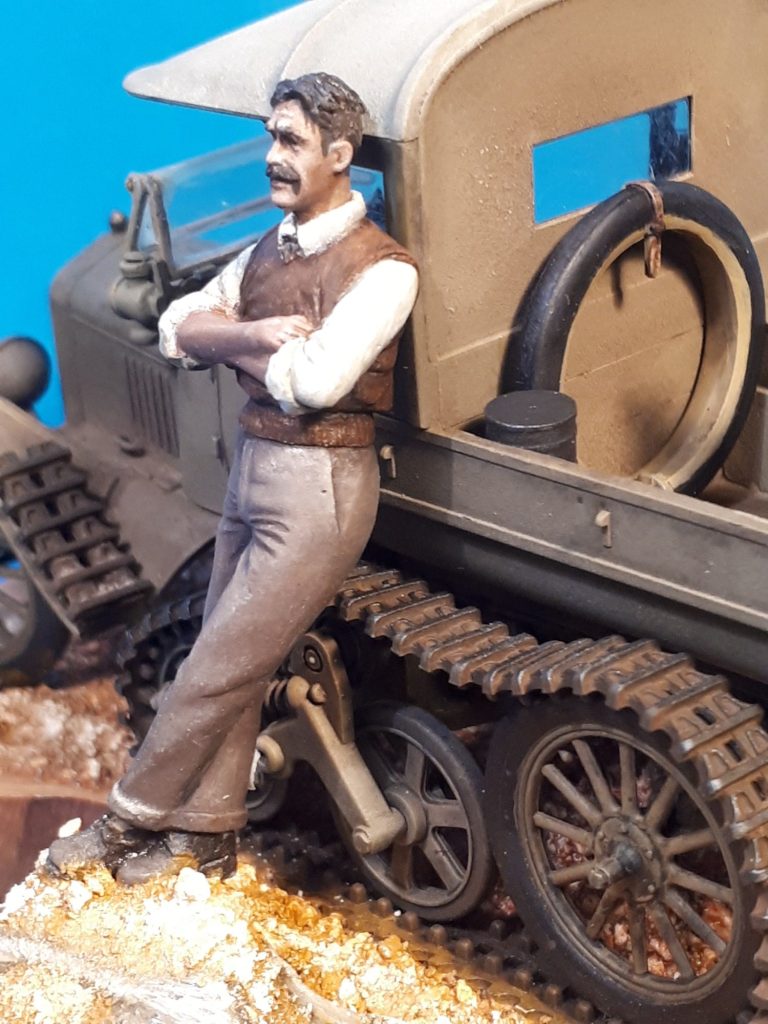
By 1938 much of Catalonia was under their influence and with Madrid cut off from Barcelona, the position of the Republican forces became hopeless.
By this time, with the loss early in 1936 of the Nationalist leaders, General Franco had become the figurehead and defacto leader of the Nationalist cause, and with Barcelona finally falling without resistance in 1939, Franco’s regime was recognised by France and the UK in February of 1939.
During that year Franco consolidated hi grip on power, entering Madrid and declaring victory in April.
Hundreds of thousands of Republican Spaniards fled to France to escape the Franco regime, although many elected to stay and were persecuted mercilessly by Nationalist factions.
Franco melded all right-wing parties into his regime to establish his dictatorship. During and certainly after the Civil War, persecution of republican supporters was rife with organised purges occurring in the captured territories along with mass executions on a lesser scale, with some amount of support from local authorities to a greater or lesser extend depending upon location.
The nature of his dictatorship changed gradually, from the brutal repression when establishing his regime, with tens of thousands killed, on the flip side he established economic prosperity for Spain and greatly improved the quality of life over time for the people of Spain.
His dictatorial style allowed for economic reform but still relied on centralised government retaining its power, with authoritarianism, Catholicism nationalism and anti-communism featuring high in held central position to the way in which he demanded his citizens behave.
The fall-out from the Civil War affected Spain’s involvement with WWII in that Franco supported Hitler’s views and made several speeches supporting the Nazi government, he excused Spain from involvement, sighting the recent weakening of his country and it’s recovery after nearly four years of conflict, and although meeting with Hitler in France in 1940, Franco’s demands of food and fuel were too much for Hitler to give.
Some historians believe that Franco made such demands, knowing that Hitler could not afford to support them, and thus he could keep Spain out of the war in Europe.
Whilst Franco allowed some Spanish soldiers to fight for Germany on the Russian front, he forbade any of them to take arms against the western European democracies.


So, my thinking here.
OK, I’ve given some space there to the Civil War in Spain and Franco’s rise to power, but to be honest I have only scratched the surface of both the war itself and it’s aftermath. There is a lot that is interesting to learn about the forty or so years following Franco coming to power, and the way in which he changed his country.
However, the model…..
I’ve had a lot of holidays over the last 30 years in Pain, and I like the country and love the people. What I do recognise is that it’s very rough terrain, and although modern roads have been cut through it, there’s still a lot of rural areas that are served by little more than cart tracks and very rutted roads.

A half track would be a logical adaptation for a vehicle in this type of countryside, especially prior to the development of four-wheel drive.
The other thing I’ve been told was that although supply of materiel to Spain was given by some countries, it was done with an ulterior motive, in that testing equipment on a proving ground is fine, but what happens in real conflict might be a lot different, and here was the perfect place to do just that – sordid, cold hearted and bloody-minded, but why endanger your own people, when there’s a whole population having a bloody good disagreement ?

The model.
Quite a simple conversion really, the set of three ICM Model T Fords still had two left in the box, the cargo truck and the four-seat town car, and it’s the former of these two that I chose because of it’s similar layout to the one in the photograph.
Strangely the rear wheels are not adapted in any way to grip the track, so they could remain as per the kit.
The extra wheels for the track looked a lot like the wheels off a Vickers light tank, or the twin idler wheels of a Universal Carrier. And if I was sourcing a cheap one of those, then perhaps the tracks could be used of that too.

The vehicle in the photo doesn’t have any apparent suspension on the road wheels other than that already on the rear wheel itself, but I thought that seeing as Vickers light tanks were existent at the time of the Civil War, then maybe one could utilise the suspension for the rougher ground of inland Spain.
And the tracks fit the Model T wheel perfectly.
After test fitting the Universal Carrier suspension and wheel assembly, and noting in the photos that the running board along the vehicle sides had been removed, I took a razor saw to the model – as shown in photos #3 and #4 – along with the Vickers gun added to a pedestal in the cargo bed.


At this point the cargo bed and upper parts of the cab are being test fitted, and were kept separate to allow ease of painting.
I’ve adapted a 1/24th scale oil can for the cooling water for the machine gun, and have a few bits of stowage that might possibly fit in the cargo bed too for ammunition storage etc.
To fit the Universal Carrier wheels – see photo #5 and a rather blurred photo #6 ( sorry ) – I had to build a step to secure them to because fitting them directly to the kit chassis would have been too narrow and too high to match the four normal wheels.
By using Blu-tac to temporarily fasten the normal wheels in place, like in these shots, I could then gauge how thick and wide the additional bits of plastic would need to be to have the Universal Carrier wheels sit correctly.
I used some scrap white plasticard, which can just about be seen in these pictures.
As well as that, I had to remove more of the running board, and curved panel above it to allow the new wheel set to sit in place.


Photo #7 shows the process of painting beginning. The separate cargo bed is shown here having been airbrushed with Desert Sand and Deck tan – both from the Tamiya paint range - and then oil paints used to paint the wood cargo bed and the canvas cab cover.
The little box on the side of the cargo bed is the kit part that usually sits on the driver’s side running board, the little box with it’s padlock detail is just too good to throw into the spares box, so it’s been relocated here.

Photos #8, #9 and #10 have leapt forward rather a lot to the vehicle in it’s finished state. A couple of oil washes have been added, the first one an overall wash to bring out the general details and add a bit of a grubby / used look to the vehicle, then some pin washes to pick out the details a bit more.
Note in this shot that the front wheels are just slightly off the ground – I hadn’t compensated for the additional thickness of the tracks being added that would raise the rear end of the car by a couple of millimetres – D-oh !
But a bit of rough terrain would sort that out.
Also in these shots I’ve added some Molotow Silver to the inside of the lights in readiness for the clear parts, and the windscreen has yet to be assembled and added too.
I planned on taking this to the SMC show in Eindhoven, along with several other pieces, so space was going to be tight in the car along with four other people, their competition entries plus on the way back all the things we would probably buy.

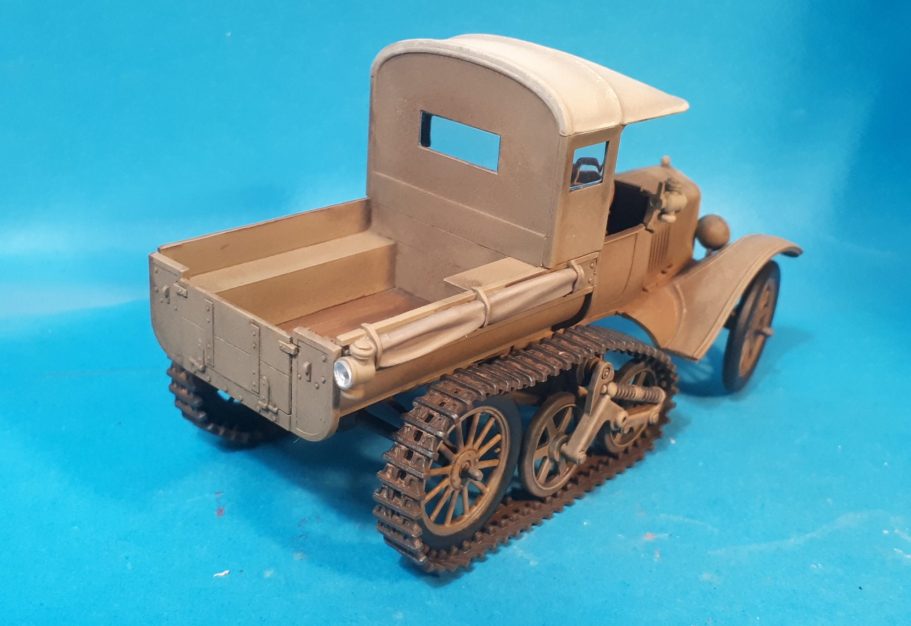

So the base needed to be relatively small, and this piece of Yew from Richard at Oakwood Studios was perfect, just allowing space of the car to sit on it, alnd possibly have a figure standing at it’s side.
I hadn’t painted the figure(s) yet, so the groundwork was limited to only what the car needed to sit on – Photo #11.
A mix of sand and cat litter was applied to the base under and around the car, carefully dribbling very thin superglue onto it to fasten it in place.

Whilst I do have a general plan in mind when I start a model, little ideas tend to spark along the way, and one of these was to have spent ammunition shells in the bed of the car – Photo #12. I used some stretched sprue, painted with Brass metallic acrylic from the Darkstar range of paints, then used a sharp scalpel to cut small lengths which were then sprinkled onto the cargo bed. To fasten them in place I dribbled on a mix of Acrylic Matt Medium and water.
Photo #13 shows a Sovereign 2000 civilian figure that I thought would go well with the car. The painting is my usual use of oils over acrylic undercoats, and utilising a simple colour scheme of browns and creams to produce a “man of the people” kind of feel.
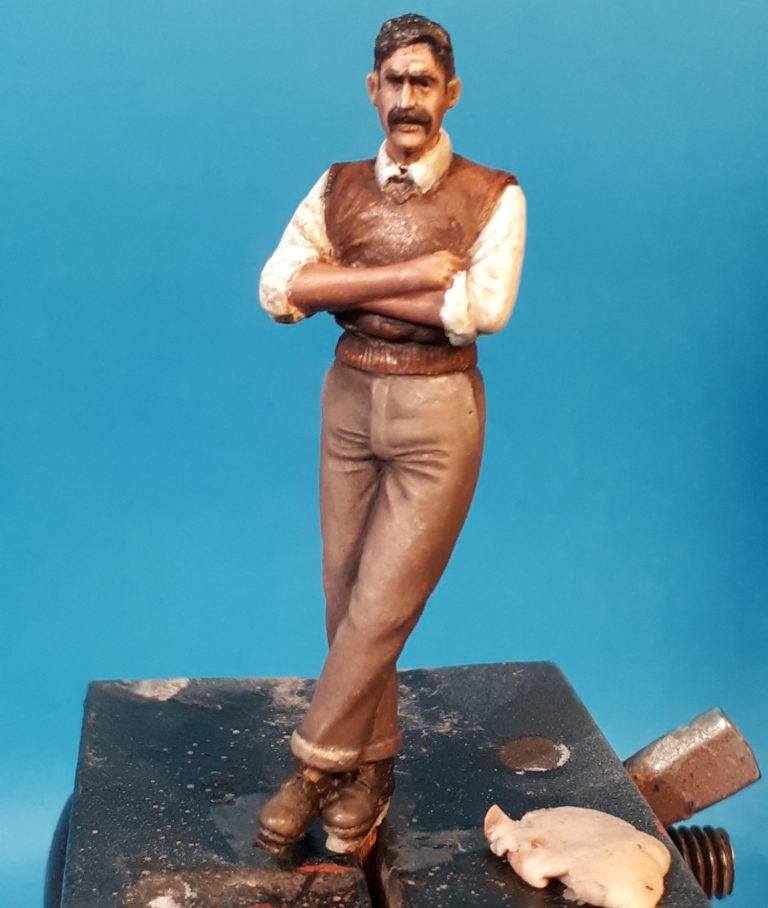

Photo #14 shows me fixing a further self-induced problem, that of the relatively small plinth allowing for not much choice in where to place the figure. Yes, I’d thought of having him leaning against the side, but hadn’t realised that:-
- A. He was only able to stand next to the tracked section of the car, and,
- B. He wasn’t tall enough for his bottom to clear the extra width that the tracked section had in relation to the side of the cab.
To solve this, I had to have him standing on something and chose a small section of wood that was buried slightly into the sand, and then with him on top of that allowing him to lean back over the top of the upper track run.
Photo #15 shows a second figure that I managed to get hold of as part of a two-figure set, this one attracting me because of the shotgun slung over the right shoulder in a very Prohibition-breaking gangster style, and he just seemed to fit in with civilian’s taking up arms to support rebellion and their own beliefs for a better future.
I did decide to swap the head for another one of the Australian offerings from the Hornet replacement heads range, the back of which is shown in this shot too.
The finished shots show both figures in position, the second figure standing in the cargo bed and ready to fire the machine gun or use the now sawn-off shotgun.
Why sawn-off, well the casting of the barrels was very thin and refused to stay straight.
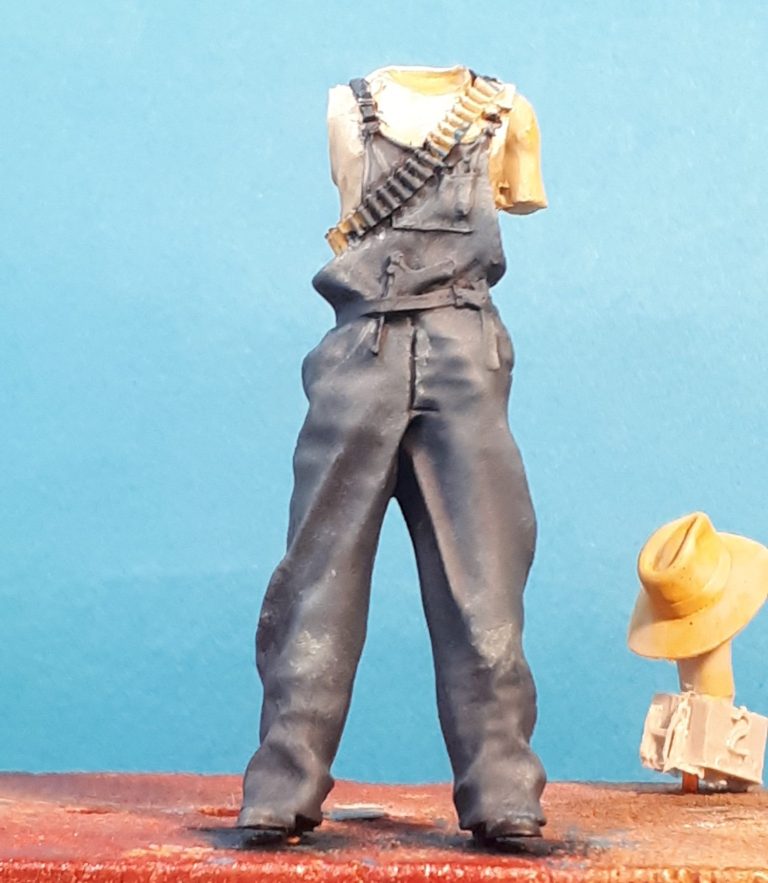

Whilst having a shotgun that would shoot round corners might seem useful, it didn’t look very threatening, so cutting it short and shortening the wood barrel supports was the only option.
I’ve added some pastel chalks to the model, using pale sand colours to make the model look dusty and a little less clean, using some of the chalks on the bottom of each figure’s trousers to make it look like they’d been out of the vehicle too.

Final thoughts.
No more conversions for a while, and back to the bench to make figures and maybe an aircraft or two.
I really liked doing this though, as spurious as the Spanish setting might be, there’s always a possibility that some farmer in the back of beyond might have had an old Ford in the barn and decided to make it a more off-road capable vehicle.
Certainly the US mail service converted Model T Fords in this way to make them more able to tackle snow and ice, although I didn’t find pictures of those until this was completed, and in hindsight I’d have made this in US postal Service livery if I’d known.

A case of that reference photo you really need turning up about a week too late – D’oh !
All that notwithstanding, the ICM kits are lovely to build, there’s a few more options to think about converting them, although ICM offer quite a few different Model T’s in their range already.
I haven’t made a great many kits from ICM, the mere handful I’ve completed have been great to build, with clear instructions and well-moulded parts.

There’s usually a few spare bits for the bits-box as well, and they seem to kit one type of vehicle and then produce a few variations of it – utilising some of the same sprues in each kit with separate sprues to make up for whichever version is in the box.
Highly recommended.





We need your consent to load the translations
We use a third-party service to translate the website content that may collect data about your activity. Please review the details in the privacy policy and accept the service to view the translations.